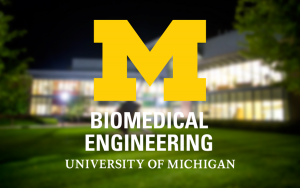Presented By: Biomedical Engineering
Master's Defense: Jonathan Primeaux
Characterization of post-operative hemodynamics following the Norwood procedure using multi-scale modeling

NOTICE: This event will be held via Zoom. The link will be placed below.
Zoom Link: https://umich.zoom.us/j/7013698675
Children with hypoplastic left heart syndrome (HLHS) must undergo multiple surgical stages to reconstruct the anatomy to a sustainable single ventricle system. Stage I palliation, or the Norwood procedure, enables circulation to both pulmonary and systemic vasculature. The aorta is reconstructed and attached to the right ventricle and a fraction of systemic flow is redirected to the pulmonary arteries (PAs) through a systemic-to-pulmonary artery shunt. Despite abundant hemodynamic data available 4-5 months after palliation, data is very scarce immediately following stage I. This data is critical in determining post-operative success. In this work, we combined population data and computational fluid dynamics (CFD) to characterize hemodynamics immediately following stage I (post-stage I) and prior to stage II palliation (pre-stage II). A patient-specific model was constructed as a baseline geometry, which was then scaled to reflect population-based morphological data at both time-points. Population-based hemodynamic data was also used to calibrate each model to reproduce blood flow representative of HLHS patients.
The post-stage I simulation produced a mean PA pressure of 22 mmHg and high-frequency oscillations within the flow field indicating highly disturbed hemodynamics. Despite mean PA pressure dropping to 14 mmHg, the pre-stage II model also produced high-frequency flow components and PA wall shear stress increases. These suboptimal conditions result from the need to ensure adequate PA flow throughout the pre-stage II period, as the shunt becomes relatively smaller compared to the growing patient size. In the future, CFD can be used to optimize shunt design and minimize these suboptimal conditions.
Chair: Dr. Alberto Figueroa
Zoom Link: https://umich.zoom.us/j/7013698675
Children with hypoplastic left heart syndrome (HLHS) must undergo multiple surgical stages to reconstruct the anatomy to a sustainable single ventricle system. Stage I palliation, or the Norwood procedure, enables circulation to both pulmonary and systemic vasculature. The aorta is reconstructed and attached to the right ventricle and a fraction of systemic flow is redirected to the pulmonary arteries (PAs) through a systemic-to-pulmonary artery shunt. Despite abundant hemodynamic data available 4-5 months after palliation, data is very scarce immediately following stage I. This data is critical in determining post-operative success. In this work, we combined population data and computational fluid dynamics (CFD) to characterize hemodynamics immediately following stage I (post-stage I) and prior to stage II palliation (pre-stage II). A patient-specific model was constructed as a baseline geometry, which was then scaled to reflect population-based morphological data at both time-points. Population-based hemodynamic data was also used to calibrate each model to reproduce blood flow representative of HLHS patients.
The post-stage I simulation produced a mean PA pressure of 22 mmHg and high-frequency oscillations within the flow field indicating highly disturbed hemodynamics. Despite mean PA pressure dropping to 14 mmHg, the pre-stage II model also produced high-frequency flow components and PA wall shear stress increases. These suboptimal conditions result from the need to ensure adequate PA flow throughout the pre-stage II period, as the shunt becomes relatively smaller compared to the growing patient size. In the future, CFD can be used to optimize shunt design and minimize these suboptimal conditions.
Chair: Dr. Alberto Figueroa